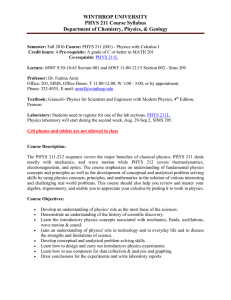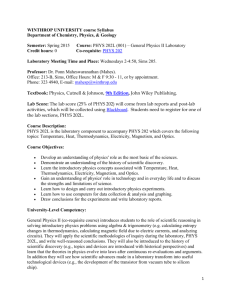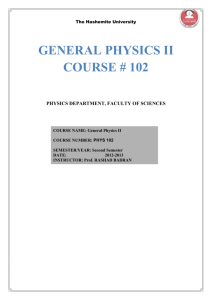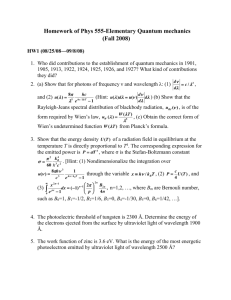PHYS 211L 001 Syllabus F2013
advertisement
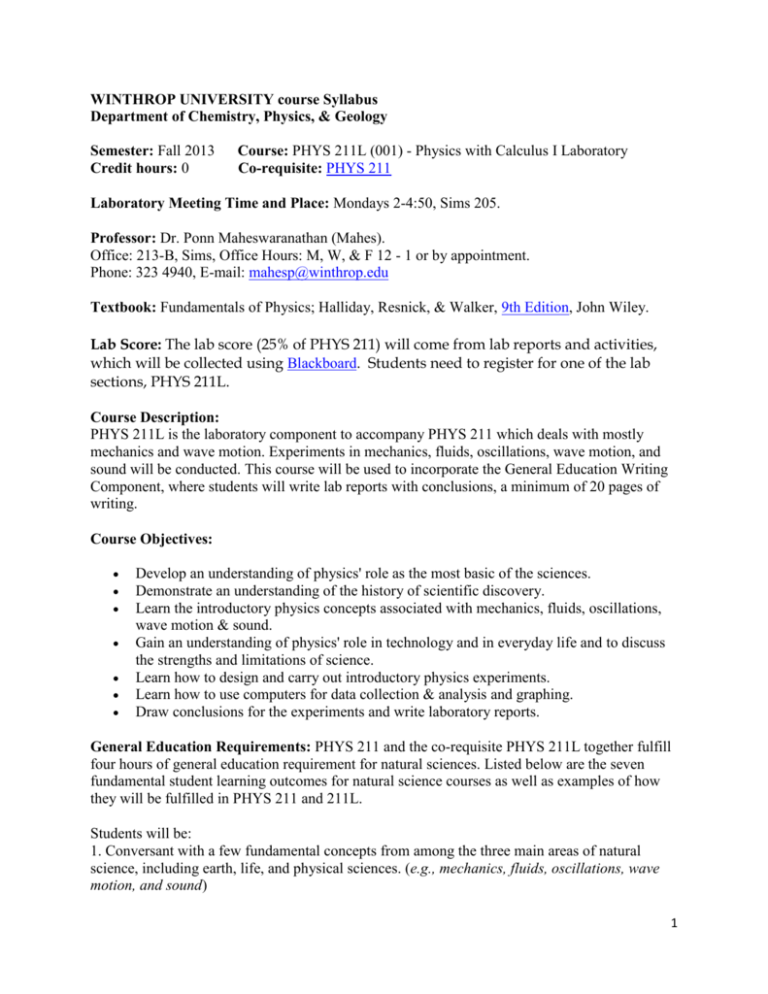
WINTHROP UNIVERSITY course Syllabus
Department of Chemistry, Physics, & Geology
Semester: Fall 2013
Credit hours: 0
Course: PHYS 211L (001) - Physics with Calculus I Laboratory
Co-requisite: PHYS 211
Laboratory Meeting Time and Place: Mondays 2-4:50, Sims 205.
Professor: Dr. Ponn Maheswaranathan (Mahes).
Office: 213-B, Sims, Office Hours: M, W, & F 12 - 1 or by appointment.
Phone: 323 4940, E-mail: mahesp@winthrop.edu
Textbook: Fundamentals of Physics; Halliday, Resnick, & Walker, 9th Edition, John Wiley.
Lab Score: The lab score (25% of PHYS 211) will come from lab reports and activities,
which will be collected using Blackboard. Students need to register for one of the lab
sections, PHYS 211L.
Course Description:
PHYS 211L is the laboratory component to accompany PHYS 211 which deals with mostly
mechanics and wave motion. Experiments in mechanics, fluids, oscillations, wave motion, and
sound will be conducted. This course will be used to incorporate the General Education Writing
Component, where students will write lab reports with conclusions, a minimum of 20 pages of
writing.
Course Objectives:
Develop an understanding of physics' role as the most basic of the sciences.
Demonstrate an understanding of the history of scientific discovery.
Learn the introductory physics concepts associated with mechanics, fluids, oscillations,
wave motion & sound.
Gain an understanding of physics' role in technology and in everyday life and to discuss
the strengths and limitations of science.
Learn how to design and carry out introductory physics experiments.
Learn how to use computers for data collection & analysis and graphing.
Draw conclusions for the experiments and write laboratory reports.
General Education Requirements: PHYS 211 and the co-requisite PHYS 211L together fulfill
four hours of general education requirement for natural sciences. Listed below are the seven
fundamental student learning outcomes for natural science courses as well as examples of how
they will be fulfilled in PHYS 211 and 211L.
Students will be:
1. Conversant with a few fundamental concepts from among the three main areas of natural
science, including earth, life, and physical sciences. (e.g., mechanics, fluids, oscillations, wave
motion, and sound)
1
2. Able to apply the scientific methodologies of inquiry. (e.g., experiments and investigations in
the PHYS 211L laboratory)
3. Able to discuss the strengths and limitations of science. (e.g., experimental error and analysis
in the PHYS 211L laboratory)
4. Able to demonstrate an understanding of the history of scientific discovery. (e.g., topics and
devices are introduced with historical perspectives)
5. Able to discuss the social and ethical contexts within which science operates. (e.g.,
environmental and health hazards of new devices and materials and sharing of knowledge)
6. Able to communicate about scientific subjects including (lab courses only) the defense of
conclusions based on one’s own observations. (e.g., PHYS 211L laboratory reports)
7. Able to discuss the application of scientific knowledge to the social sciences and to nonscientific disciplines. (e.g., application of technology in everyday life)
Attendance and Participation:
The attendance policy described in the Winthrop University undergraduate catalog will be
followed. Students are encouraged to attend all the labs and to actively take part in laboratory
activities.
Students with Disabilities:
Winthrop University is dedicated to providing access to education. If you have a disability and
need classroom accommodations, please contact Gena Smith, Coordinator, Services for Students
with Disabilities, at 323-3290, as soon as possible. Once you have your professor notification,
please tell me so that I am aware of your accommodations well before the first
{test/paper/assignment}.
Student Conduct Code: The policy on student academic misconduct is outlined in the “Student
Conduct Code Academic Misconduct Policy” in the online Student Handbook
(http://www2.winthrop.edu/studentaffairs/handbook/StudentHandbook.pdf).
Syllabus change policy: The instructor will make changes to this syllabus as deemed necessary
for the progression of the course.
Rules for the laboratory:
1. You must read the web-link and the relevant materials from the textbook before the lab
period and be prepared for the laboratory.
2. You will work in a group of two. Both partners should actively take part in collecting the
data and in the experimental process.
3. At the end of your lab work you need to return all the laboratory equipment to the
appropriate places where you took them.
4. You need to handle the equipment carefully, giving special attention when warranted.
5. When you leave the laboratory, you need to make sure the laboratory table is clean and
free of any materials.
6. Do not miss any laboratory. You will receive "0" for all missed laboratories.
7. Lab reports are due at the end of the lab period, unless advised otherwise by the
instructor.
2
LAB SCHEDULE
Lab #
Monday Lab
Experiment
1
2
3
Aug. 26
Sept. 2
Sept. 9
Graphing with Excel
Density
Vectors
4
Sept. 16
Data Collection with a PC
5
6
7
8
9
Sept. 23
Sept. 30
Oct. 7
Oct. 14
Oct. 21
Oct. 28
Friction
Energy
Ballistic Pendulum
Fall Break
Torque
Rotational Motion
10
Nov. 4
Hooke's Law and SHM
11
12
13
Nov. 11
Nov. 18
Nov. 25
Archimedes' Principle
Vibrating String
Speed of sound in air
Lab Reports:
At the completion of each lab every student is required to turn in a lab write-up. Students may
work with their partner(s) to complete most of the write-up. This means sharing ideas not
paragraphs. However, the conclusion section must be completed independently! Students are
encouraged to be creative with their conclusions and explain whether or not their results are
accurate. If the results are not close to the accepted values student are expected to give reasons
for any discrepancies. The conclusion section is the part of the lab which is most important to
check for student comprehension of the topic.
How to write a conclusion?
* Conclusion is the most important part of your report. It is a brief summary-paragraph, about
half a page. You must write your own conclusion, after completing the data collection and
analysis. It must be written as the last piece and attached after data tables and graphs.
* Conclusion should state things that are unique for your investigation which can be
accomplished by including values of the experimentally determined physical quantities. Just
remember that you cannot write your conclusion without completing your experiments or
investigations. General statements like "I have determined the densities of given solids" is not
acceptable.
3
* You may start your conclusion by re-stating the purpose with appropriate changes. Then you
need to briefly state (don’t repeat procedure) how you conducted the experiment and collected
the data. Continue this with summarizing your results, referring to the data tables and graphs
when appropriate, and answer the purpose. Then you may discuss about some of the difficulties
you had, errors and their possible causes, and suggestions for improvement. Describe your
reasoning using physics terminology and principles. You should explain as completely as
possible what goes through your mind that leads you to your conclusion. While we encourage
you to discuss the investigations with your partners, your conclusion must be your own thought.
4
